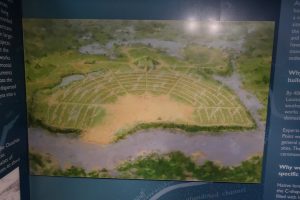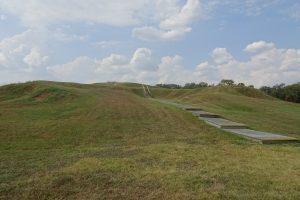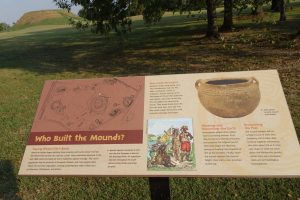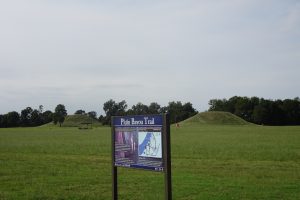3-4 Oct: We were especially eager while in northern Louisiana to visit Poverty Point, an ancient mound and earthwork complex that is a UNESCO World Heritage Site. There are many ancient Native American mound sites in the southeastern and Midwestern states, particularly in the Ohio, Tennessee, and Mississippi river bottomlands, but Poverty Point is exceptional because (1) it was a very large city for its time, (2) it was built by people who were still primarily hunter-gatherers and did not farm to provide their main food source, and (3) it was built about 2,000 years before its largest earthwork was matched or surpassed in size by any other mound in North America. Poverty Point is considered to have been North America’s first major city, far larger than other population centers of its time (1650-1100 BC). It was constructed in an unusual configuration, with six concentric semi-circular ridges around one side of a large plaza. Small individual family dwellings were constructed on those ridges. Just outside of the concentric ridges is a very large mound (“Mound A”), the second largest in North America, after Cahokia’s Monk’s Mound. Erosion has taken its toll on Mound A for more than 3,400 years, and treasure seekers did some digging in it looking unsuccessfully for unrecovered spoils of the Jesse James gang’s spree of bank and train robberies, but the mound’s shape appears to resemble a bird in flight. The whole Poverty Point mound and ridge complex was built entirely by human labor using millions of basketfuls of dirt. Mound A alone required an estimated 15.5 million basket loads of 50 pounds each. It was apparently completed very rapidly, in as little as 90 days. Considering the huge scale of the project, this was a major accomplishment, requiring sophisticated planning and coordination of a large work force. Millions of artifacts have been recovered at the site, characterizing the inhabitants’ way of life in detail and demonstrating that they had a wide-ranging trade network.


After our visit to Poverty Point, we briefly visited two other ancient mound sites: Winterville Mounds and Toltec Mounds, which are Mississippi and Arkansas archaeological state parks, respectively. These both represent the Mississippian culture. The Toltec mounds (no relation to the Toltecs of ancient Mexico) were occupied during 600-1050 and the Winterville mounds were built about 1220-1250. Mounds in these and other Mississippian sites varied in their shape and use. Platform mounds (truncated pyramid shape) were common, but others were conical, rounded, or low and flat. Large mounds were probably ceremonial centers, some were used as burial mounds, and some had dwellings or other structures on top. Most remains of mounds and other earthworks such as these were abandoned so long ago that Native Americans living when the first Europeans arrived did not know who built them. They may have been abandoned because of depletion of local resources, unfavorable changes in climate, warfare, or other reasons. Some mound building even continued into historical times and was witnessed by the Spaniards.

